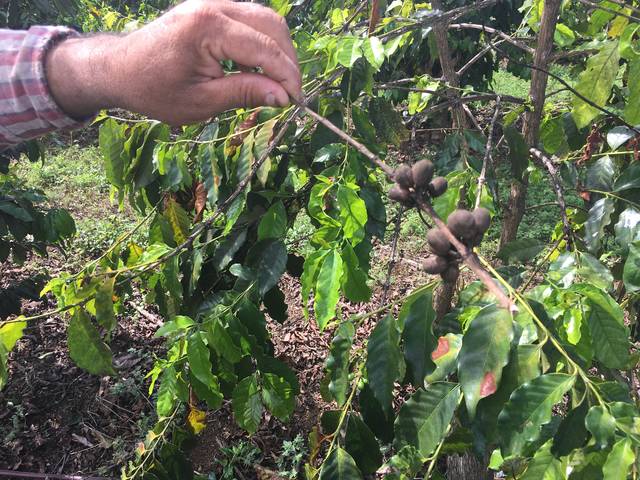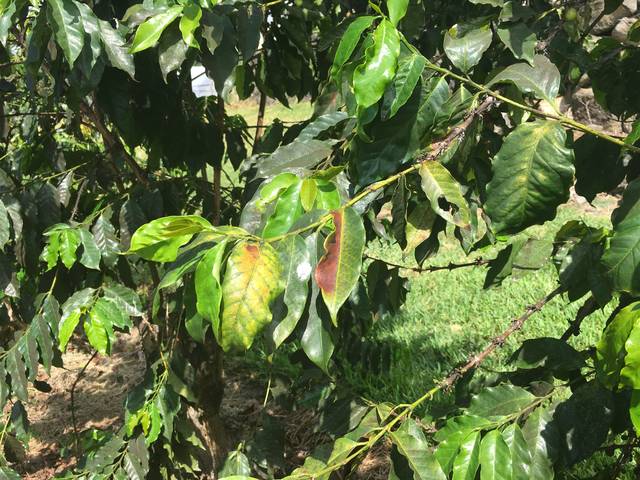KAILUA-KONA — Coffee season ended abruptly, some two months earlier than usual, for West Hawaii farmers. While causation is likely multi-faceted and open to debate, the consequences creep closer to certainties.
Yield for 2018 will drop significantly from average levels, which will create a seller’s market and push prices upward, though likely not high enough to offset hits to bottom lines across the region.
Suzanne Shriner, president of the Kona Coffee Farmers Association, said anecdotal evidence generated from member reports points to as high as a 30 percent dip in yield for many local farmers.
Armando Rodriguez, proprietor of the King’s Cup 100% Kona Coffee brand, sells both green and roasted products. One of the farms he works in Kealakekua was expected to pull down 40,000 pounds this season.
His adjusted projection Monday was that pickers would harvest around 16,000 pounds, a yield reduction of 60 percent.
Even working with better prices, sellers will have a tough time beating the numbers. While Shriner believes the price of green beans will push to around $18 per pound, which she said is “approaching record levels,” the market rate for cherry is expected to remain relatively flat.
“That’s probably up about $1 a pound from last year,” Shriner said of the expected price of green. “But if you figure that we’re (down) 30 percent yield, and the price is going up not even 10 percent, there’s still a pretty big difference for the farmers.”
“And the cherry price is the same as last year,” she added. “For people who don’t sell green coffee, all they’re seeing is the loss.”
Stuart Nakamoto, extension economist with the College of Tropical Agriculture and Human Resources at the University of Hawaii at Manoa (UH-CTAHR), agreed.
“If they’re seeing that big of a drop, that’s got to hurt the bottom line,” he said. “I don’t think prices are going to adjust that much.”
Nakamoto added such a significant decrease in yield would put most small farms out of business if they relied solely on coffee to remain financially viable. Luckily, he explained, coffee isn’t the primary source of income for many small farmers working across the Kona coffee belt.
Matthew Loke, a researcher at UH-CTAHR, said most mom and pop operations don’t sell green coffee. They roast their own and sell it online because that process lends itself to greater profitability for a smaller outfit.
“They’re able to get a better price because I believe they have a loyal following,” he said.
The Kona brand is capable of commanding a higher online price for the finished product due to the principles of supply and demand that accompany a season like that of 2018.
But if the yield drop stretches upward of 30 percent on average due to the shorter season, it’s hard for most experts to see a clear path to anything near the level of profitability that would correlate with a full season of normal production.
Hampered harvest
Farmers and researchers named a number of factors that likely contributed to cutting the coffee season short — less rainfall between April and June, increased vog manipulating the amount of light at different times during the season and the availability of labor.
And while the connections aren’t always entirely clear, many in the industry tied these effects to the most recent eruption at the Kilauea volcano, which stretched from May to August.
It starts with the rain. Coffee typically flowers when there’s a dry period followed by significant rainfall. Andrea Kawabata, extension agent at UH-CTAHR’s West Hawaii location, said the major bloom period is triggered by such patterns between March and June.
“When we had the volcano going, we had a really dry stretch,” she said. “I think that could have contributed to our shortened season.”
Shriner believes elevated vog levels dictated light patterns at a crucial time in the season and impacted yield. She referred to a report from the U.S. Pacific Basin Agricultural Research Center in Hilo, which documented a notable reduction in available photosynthetic radiation during the eruption.
John Ah San, a farmer and roaster based in Ka‘u, said farms in that swathe of the coffee belt didn’t have as strong of flowerings this season as the year before. He believes that’s particularly true of higher elevation operations because they didn’t receive as much sun.
Shriner said she believes the combination of less rain and less sun early in the year contributed to less production and the shorter season, which actually led to more sun at the wrong time after the vog cleared. That turn of events didn’t provide ideal conditions for production as it exacerbated an already strained labor market.
“When the coffee gets more sun (at that point in the season), it ripens rapidly,” she explained. “So instead of going a month between harvests, we have to harvest about every two weeks, which creates a terrible issue with labor. It’s hard enough to get labor for our farms as it is.”
Nakamoto, who grew up in West Hawaii, warned of putting too much blame on the eruption and the resulting impacts on weather patterns. He said doing so is dangerous because it ignores threats to coffee production in Kona and Ka‘u, both new and endemic.
Among those threats are the coffee berry borer, which is manageable but also eats into profit margins. Then there’s the root-knot nematode, a more insidious threat that moves gradually enough it can be harder to recognize.
“There’s also a black twig borer that seems to be pretty bad this year,” Nakamoto said.
Rodriguez showed examples of branches the borer destroyed on some of the trees he’d cultivated. The branches the borer infiltrates will break off and whatever is on them is lost.
Decades ago, the average expected yield was 10,000 pounds of coffee per acre, Nakamoto said. Today, due to various threats, average yield is a little higher than 3,000 pounds per acre, a number dragged upward only by higher producing farms on Kauai.
He added if such threats are not properly addressed, coffee yield and profits will continue to suffer in years to come, eruption or not.


